Author(s): Bindu Bharathi* and Deepa Jothirajan
Background: Effective communication is the key element in providing comprehensive high-quality nursing care to the patients.
Aim: Aim of the study was to explore the pattern, skills, and style of communication among the professional nurses and the problems faced by the nurses during communication.
Methodology: A quantitative research approach with exploratory descriptive design was used in this study. This study was done at selected hospitals of Saudi Arabia. Professional nurses were the population of the study. Proportionate stratified random sampling technique was used in this study. The investigators randomly selected the subjects proportionately from different hospitals of Arar Province. Nurses from selected hospitals of Arar Province were the sample of this study with the sample size of 100. Before starting the data collection process written permission was taken from the ethical committee and administrators of the hospitals. Informed written consent was taken from all the participants of the study. Through the structured questionnaire, the researchers collected the data from the subjects regarding socio-personal variables of professional nurse, pattern of communication, skills of the professional nurses needed for the communication, style of communication and the problems faced by the professional nurses during communication. The data were obtained from the sample through observation and interview. Throughout the study, the researchers maintained the confidentiality and anonymity of the subjects.
Results: Analysis of the study depicts that 38 percent of the subjects were belongs to the age group of 20-30 years, but 16 percent of the samples were between the age group of 51-60 years. Majority (78 percent) of the samples were females whereas 22 percent of the subjects were males. About 46 percent of the subjects were Saudis, but 30 percent of the subjects were Indian nurses. Majority (79 percent) of the samples were B.Sc. nurses and 88 percent of the samples were staff nurses / nurse technicians. Majority (84 percent) of them were working under ministry of health hospitals of Saudi. Around 41 percent of the subjects were having the experience of 1-5 years, whereas 8 percent of the staffs were newly joined, they have no experience. Regarding pattern of communication, 39 percent of the Nurses were having very good pattern of communication, whereas 28 percent of the subjects were maintaining excellent pattern of communication with their clients. About 19 percent of the Nurses were having excellent skill in communication. More than fifty (57%) percent of the Nurses were having very good style of communication. About 25 percent of the participants were facing the communication problems of incivility and rude behaviour, whereas 19 percent were suffering from intimidation. Around 22 percent of the participants were the victims of humiliation. About 16 percent were suffering from physical violence but 18 percent nurses were the victims of bullying. There was a significant association between socio-personal variables and pattern, skills, style, and problems of communication among professional nurses, P<0.05*. Hypothesis of the study revealed that there was a significant positive correlation between socio-personal variables and style of communication and problems faced by the professional nurses during communication. Correlation is significant at 0.05* level.
Conclusion: This study recommends that effective communication improves productivity and promotes team-building among professional nurses.
As a nurse, communicating with patients and their families is one of the most important parts of our job. Communication is the act or process of using words, sounds, signs, or behaviours to express or exchange information, ideas, thoughts, feelings, etc., to someone else. Communication has been found to be a vital part of the nurse-patient relationship and is based on the formation of trust and personal attitudes.
Effective communication plays an instrumental role in patient’s entire healthcare experience, and a large portion of the responsibility falls on nurses. Nurses must be able to communicate clearly, especially during periods of intense stress. Good written and verbal communication is one of the soft skills required for the nurses. Effective communication is the key element in providing comprehensive high-quality nursing care to the patients.
For successful care delivery, there must be an effective communication between nurses and patients. When patients are unable to speak, it becomes difficult for nurses to communicate with them. The fact that nurses usually not receiving any training on using augmentative and alternative communication (AAC) to communicate with the patients who have communication problems [1].
A key component of patient care is effective communication, which enhances the nurse-patient bond and has a significant impact on the patient’s opinions on the standard of care and treatment results [2].
In this article, they stated that, to enhance communication and teamwork, a medical resident and nurse education program was put into place. It has been shown that nurse job satisfaction and patient outcomes are enhanced when team members communicate and work together [3]. This article presents the program’s outcomes and outlines it.
Healthy communication techniques are something that nurses may constantly employ to their advantage in both their personal and professional life. When nurses use good interpersonal communication techniques in both personal and professional contexts, stress can be reduced, wellness can be promoted, and overall quality of life can be improved [4]. As the central point of contact for doctors, caregivers, patients, and family members, nurses translate and disseminate information. In order to provide the best care and results for patients, nurses must be able to communicate effectively.
An investigation of patients’ experiences in nurse-patient communication context; a fundamental aspect of nursing is patient-centered communication, which helps to build a good rapport between the nurse and the patient. This, along with other organizational elements, leads to the provision of high-quality nursing care. Although nurses are usually characterized in the literature as having poor communication skills, very few researches have looked at patients’ perceptions of nurses’ communication styles [5].
As per the opinion of the main intention of communication and interaction in the health setting is to influence the patient’s health status or state of well-being [6]. The importance of communication and interaction for nursing has been an often-stated point by nurses and nursing scientists since Florence Nightingale in the 19th century and continuing until today. There are several ways to define or study the phenomenon of communication and interaction between nurses and patients. As the healthcare team members who spend the most time interacting with patients and residents of nursing homes, nurses inevitably occupy a position of obvious importance in meeting patients’ communication needs.
Communication in nursing not only gets benefits to the patients, but also the nurses as well. Nurses who communicate well with their co-workers tend to witness an improvement in morale as well as job satisfaction. Negative effects of poor workplace communication are high turnover rates, increased stress, and lower morale and job satisfaction are among the many downsides (www.nursingworld.2014).
Nurses concluded that one of the most crucial tools in their interactions with patients is communication. Patients and clients benefit from effective communication in three primary ways: it puts them at rest, gives them a sense of control, and makes them feel important.
Most of the Nurses are good communicator, so through this study the researcher would like to assess what pattern of communication followed by the Nurses? What are the skills used by the Nurses during communication? What is the style of communication followed by the Nurses? The investigator also wanted to identify the problems faced by the Nurses during communication.
An Exploratory Study to Assess the Communication Pattern, Skills, Style and Problems of Communication among the Professional Nurses of Saudi Arabia
Aim of the study was to explore the communication pattern, skills, style and problems faced by the professional nurses during communication.
h4: There will be a significant association between the socio- personal variables of the professional nurses with communication pattern, skills, style and problems faced by the professional nurses during communication.
H2: There will be a significant correlation between the socio- personal variables of the professional nurses with communication pattern, skills, style and problems faced by the professional nurses during communication.
A quantitative research approach with exploratory descriptive design was used in this study. This study was done at selected hospitals of Saudi Arabia. Professional nurses were the population of the study. Nurses from selected hospitals of Arar Province were the sample of this study with a sample size of 100. Proportionate Stratified Random Sampling Technique was used in this study. The investigator randomly selected the subjects proportionately from different Ministry of Health Hospitals of Arar Province. Nurses from selected hospitals of Arar Province were the sample of this study. Selected Ministry of Health Hospitals was the settings of the study.
After review of literature and discussion with experts of nursing profession, the researcher developed research tool i.e. structured questionnaire, which includes:-
Section I: Socio-personal variables of professional nurses Section II: Pattern of professional communication with the patients Section III: Communication skills of the professional nurses Section IV: Style of communication among the professional nurses Section V: Problems faced by the professional nurses during communication
Before starting the data collection process, written permission was taken from the ethical committee and administrators of the hospitals. After explaining the purpose and objectives of the study, informed written consent was obtained from all subjects of the study. Throughout the study the researcher-maintained confidentiality and anonymity of the participants. There was no conflict of interest.
Through the structured questionnaire, the researcher collected the data from the subjects regarding socio-personal variables of professional nurses; pattern of communication; communication skills of nurses; methods of communication style; and also problems faced by the professional nurses during their communication. The data were obtained from the sample through the observation and interview. Throughout the study, the researcher maintained the confidentiality and anonymity of the participants. There was no conflict of interest.
Nurse Managers and nurse administrators and night duty staffs were excluded from this study.
Dependent Variable: Communication problems faced by the professional nurses.
Independent Variables: Socio personal variables of professional nurses, patterns of communication, communication skills, and style of communication and problems faced by the nurses during communication.
Descriptive and inferential statistical techniques were used to analyze the data. Descriptive statistical techniques were used to assess the frequency and percentage distribution of the subjects like socio-personal variables, pattern, skills, style and problems faced by the nurses during their communication.
Inferential statistical test like Pearson Correlational Coefficient (r) test was used to identify the correlation between socio- personal variables of the professional nurses with communication pattern, skills, style and problems faced by the professional nurses during communication. Chi-square (?2) test was used to identify the association between the socio- personal variables of professional nurses with communication patterns, style and skills of professional nurses of different ministry of health hospitals of Saudi Arabia.
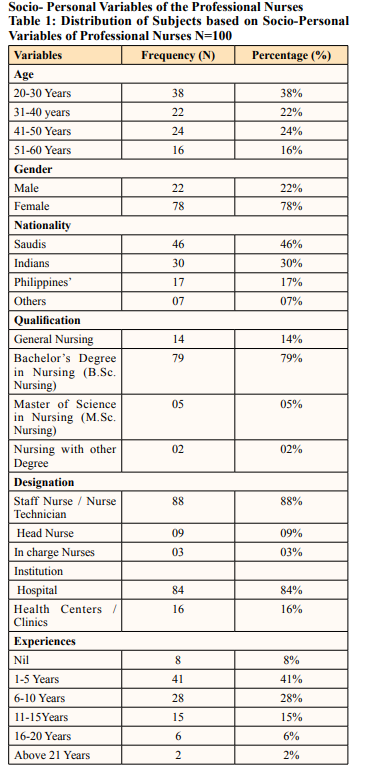
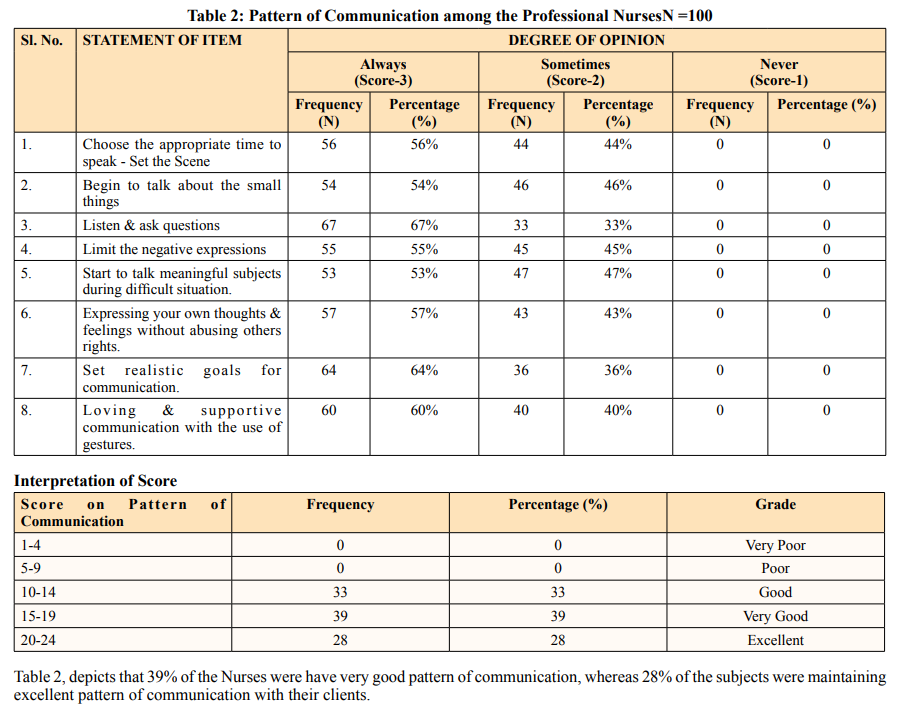
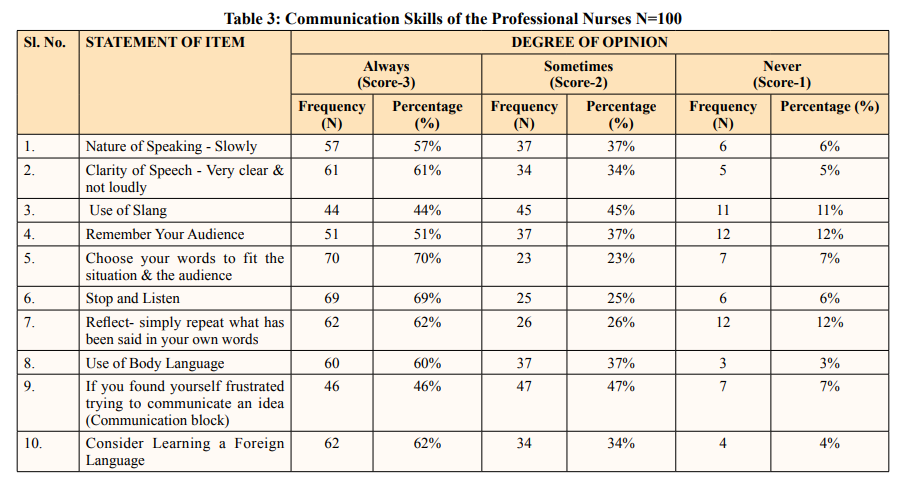
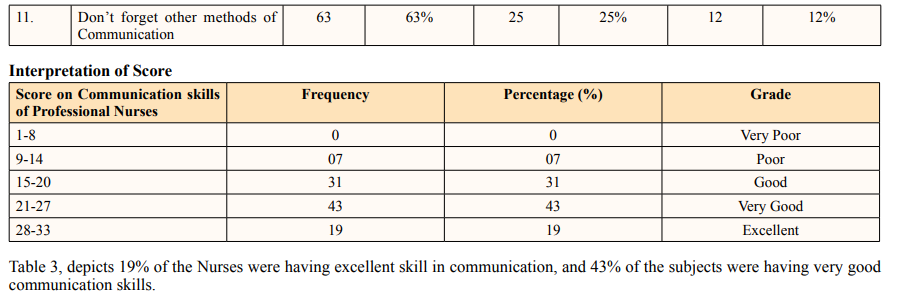
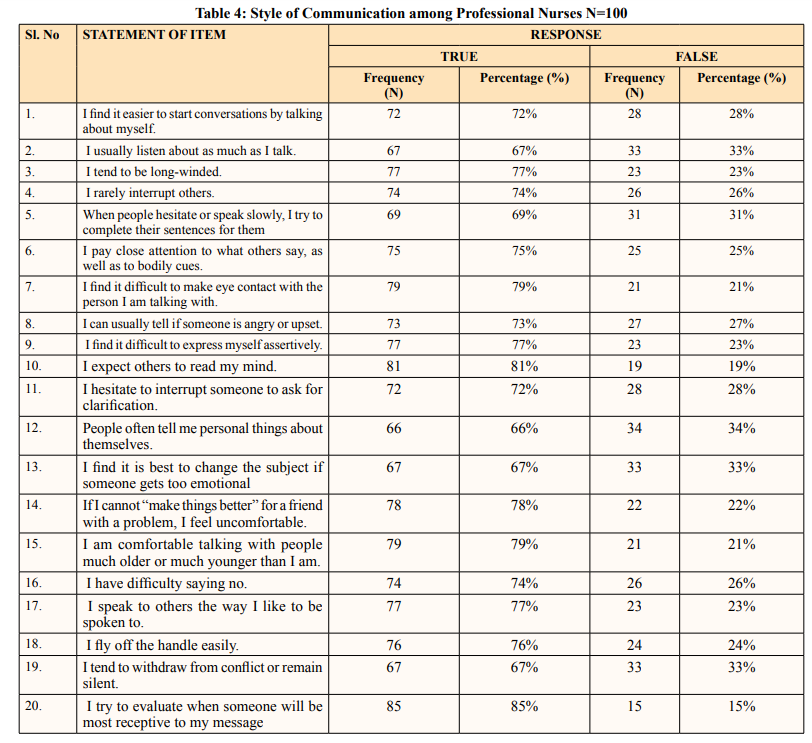

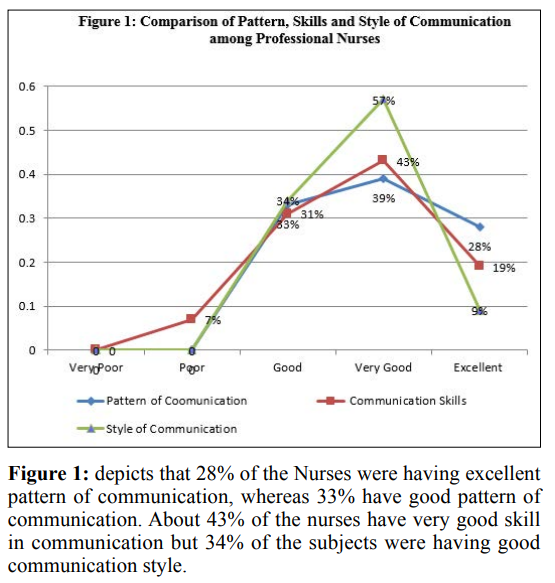
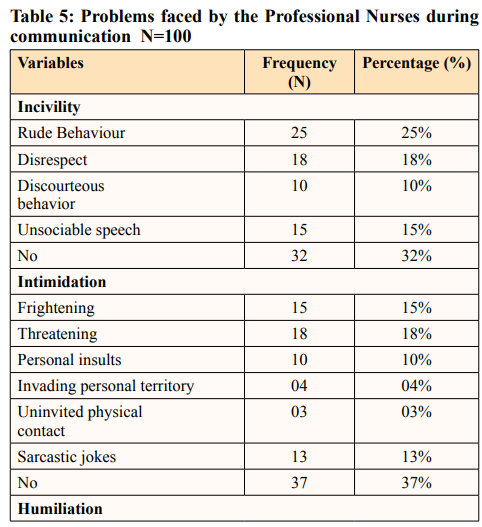
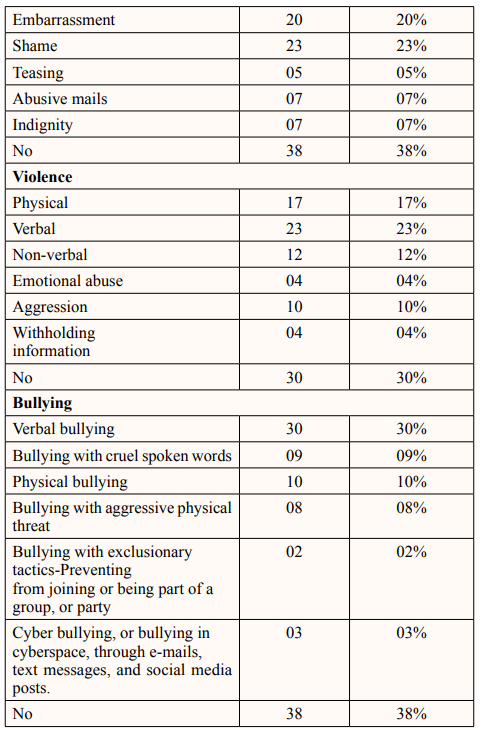
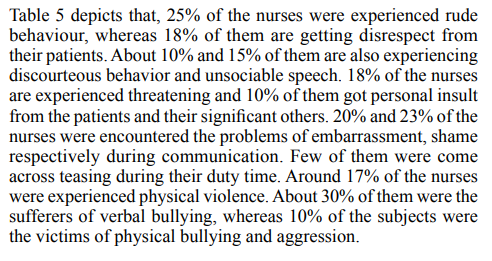
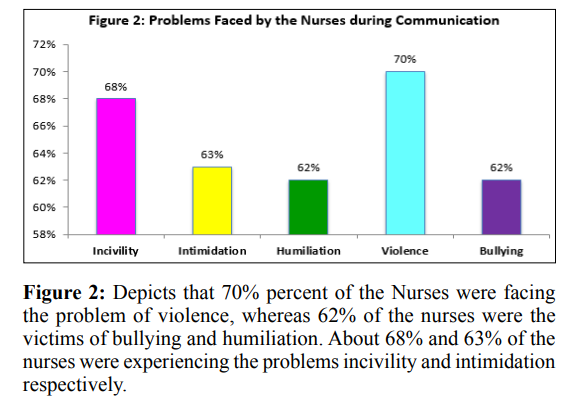
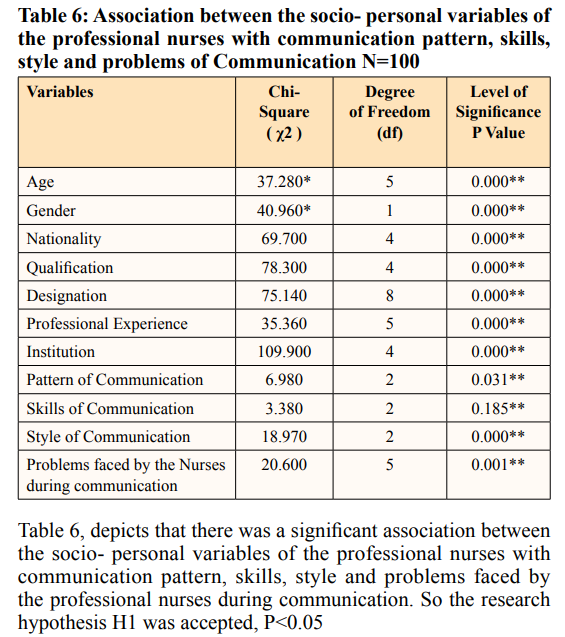


Present study results demonstrated that 19% of the Nurses were having excellent skill in communication, and 43% of the nurses have very good skill in communication. This study was supported with study of she highlights the importance of effective communication skills for nurses [7]. It focuses on core communication skills, and the positive outcomes that result when applied to practice. Effective communication is central to the provision of compassionate, high-quality nursing care. It was also supported by the study of in their study 60 participants were attended, they agreed that preadolescents have a pattern of aggressive behaviour or passiveness [8]. There is a need among students to create an orientation towards interpersonal communication for success in the future and for the formation of human society. The teacher must realize the importance of communication in their relationships with students and encourage the development of quality communication skills to help children communicate better in the future. Communication skills are very important for the future personality of the young person.
Present study findings depict that more than fifty (57%) percent of the Nurses were having very good style of communication, whereas 9% of the Nurses were having excellent style of communication. About 34% of the subjects were having good communication style.
It was supported by the study of emphasized that, the communication style is an indicator of a pattern of a person organises his interpersonal relationships [8]. This article aims to develop a more conscious style of communication with patients and carers, with the aim of improving health outcomes and patient satisfaction. In fact, the style of communication is a way which shows how the pupils see and judge the information around them. According to these, the teachers, families can improve their interactions. The art of effective communication should not just stop at the correct use of language, but also at other forms of communication. We have proposed to present a theoretical and practical approach about how the gender of pupils influences communication, with the objective of preventing conflicting style. It includes four styles – aggressive, assertive, persuasive and passive. It was also supported by the study findings of Harriet Coeling and Penelope Communication Styles that Promote Perceptions of Collaboration, Quality, and Nurse’s Satisfaction [9]. Norton’s Theory of Communicator Styles was used as a framework to identify the effect of three specific communication behaviours (styles)--namely, dominant, contentious, and attentive styles--on nurses’ perceptions of collaboration, quality of care, or satisfaction with the interaction. Suggestions for teaching these three styles to health care professionals are provided.
Present study results shows that, 39% of the Nurses were having very good pattern of communication, whereas 28% of the subjects were maintaining excellent pattern of communication with their clients. About 33% have good pattern of communication. This findings was aligned with the study report of, on Patterns of Medical and Nursing Staff Communication in Nursing Homes: Implications and Insights From Complexity Science, the authors sought to compare the effects of differing patterns of medicine-nursing communication on the quality of information flow, cognitive diversity, self-organization, and innovation in nursing homes [10]. The patterns of communication between care providers in nursing facilities have an important impact on their ability to provide quality, innovative care. Open communication pattern between medical and frontline staff. The authors saw higher levels of information flow, cognitive diversity, innovation, and self-organization, although tempered by staff turnover. The thoughts, feelings and behaviours of family caregivers and nurses that might create positive or negative circular patterns of communication are evidenced. Further research is required to gain a more comprehensive understanding of the phenomenon. Nurses must be trained in how to communicate with family caregivers in order to form a partnership geared to preventing complications in hospitalised older persons. This study was also supported with the qualitative study of on High-fidelity simulation in communication, findings suggest the importance of using high- fidelity simulation to develop expertise in communication [11]. Thematic analysis revealed that the patterns to focusing on tasks, communicating-in-action, and being therapeutic. It is also agreed that the importance of effective nurse–patient communication is reflected in the graduate outcomes of most nursing programs (American Nurses Association and Quality and Safety Education for Nurses).
Current study reports shoes that 25% of the nurses were experienced rude behaviour, whereas 18% of them are getting disrespect from their patients. 10% of them got personal insult from the patients and their significant others. 20% and 23% of the nurses were encountered the problems of embarrassment, and shame respectively during communication. Around 17% of the nurses were experienced physical violence. About 30% of them were the sufferers of verbal bullying, whereas 10% of the subjects were the victims of physical bullying and aggression. Majority (70%) of the Nurses were facing the problem of violence, whereas 62% of the nurses are the victims of bullying and humiliation. About 68% and 63% of the nurses were experiencing the problems incivility and intimidation respectively. It was supported by the study of environmental scanning allows nursing professional development practitioners to determine what factors are influencing practice and what programs and activities are needed. Incivility, bullying, diversity, inclusion, and self-care are all surfacing as key factors impacting the healthy work environment [12]. Nursing professional development practitioners can provide programming to address this. Findings of, study indicate that, in contrast to the literature suggests that nurses are not good at communicating with patients, nurses can communicate well with patients when they use a patient-centred approach [5]. However, health care organizations do not appear to value or recognize the importance of nurses using a patient-centred approach when communicating with patients to ensure the delivery of quality patient care [13]. they pointed out that, good communication between nurses and patients is essential for the successful outcome of individualized nursing care of each patient. To achieve this, however, nurses must understand and help their patients, demonstrating courtesy, kindness and sincerity. Also they should devote time to the patient to communicate with the necessary confidentiality, and must not forget that this communication includes persons who surround the sick person, which is why the language of communication should be understood by all those involved in it. Good communication also is not only based on the physical abilities of nurses, but also on education and experience.
Current study findings shows that there was a significant association between socio- personal variables of the professional nurses with communication pattern, skills, style and problems faced by the professional nurses during communication. This study was supported with the findings of they try to know the extent of the relationship between the interpersonal communication skills (leadership, communication process, motivation, and negotiation skills) of the nurse managers, (independent variable), and the performance of nurses, (dependent variable) [14]. The results showed a significant relationship between the interpersonal communication skills of the nurse managers and the performance of the nurses. The test results also showed that there was a significant difference between the interpersonal communication skills of the nurse managers and the performance of nurses.
When nurses use good interpersonal communication techniques in both personal and professional contexts, stress can be reduced, wellness can be promoted, and overall quality of life can be improved.
They benefit from effective communication in three key ways with their patients/clients: Effective communication puts clients and patients at ease; Effective communication gives clients and patients a sense of control;, Effective communication helps clients and patients feel important.
Good connections, cooperation, and collaboration are all fundamental to professional practice, and communication is at the heart of these. Patient outcomes are significantly impacted by the nurses’ and patients’ communication quality during contacts. Improved communication between nurses can reduce medical errors and improve patient outcomes. Since everyone has a natural ability to communicate, it might be challenging to alter nurses’ communication styles and pattern of communication [15].
Effective communication is a critical component of providing high-quality nursing care to all patients. Nurses must possess the knowledge and abilities to interact with them all. Nurses act as the pivot of communication, relaying and interpreting information between physicians, caregivers, family members and patients. The ability to establish effective communication in nursing is imperative to providing the best care and patient outcomes possible. Patients receive high-quality nursing care, health care management must recognize the importance of patient- centered communication and take steps to support and encourage nurses who communicate in this way. This study recommends that effective communication improves productivity and promotes team-building among professional nurses.
All authors have no conflict of interest.
